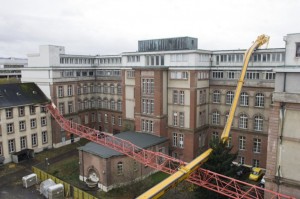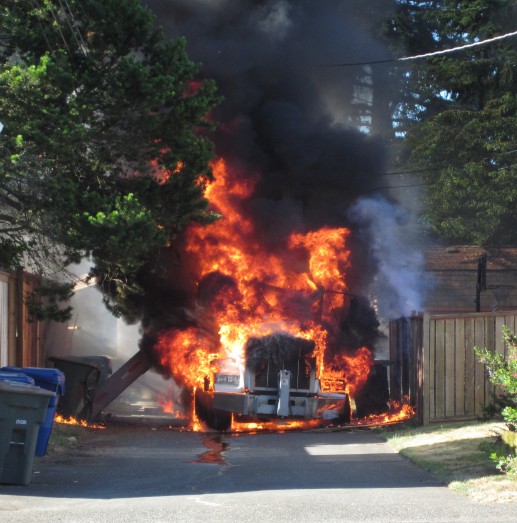
Basel, Switzerland A Wolff tower crane jib, apparently being dismantled, was dropped due to stability problems with the mobile crane. The Tower crane jib will be a total loss, as well as the mobile crane boom and luffing jib. One woman was injured. It sounds as if she was in a room on the opposite side of the crane where a wall was destroyed in the impact.
Speculation as to ground stability, the operator swinging too quickly load, and the light counterweight configuration, have been put forth. I’m looking at the pictures and thinking that the load was relatively low in relation to the boom judging by it’s landing. I’d be surprised to think that he was still swinging, and to think of swinging quickly in this tight area doesn’t ring true to me. The ground doesn’t appear to have unsettled the crane in an unusual way with one outrigger higher than the other. And the counterweight configuration being wrong is so elementary, that the crane’s LMI would have to be disabled. Worse things have happened, but I find it hard to imagine this is the case. There is another option that rings true to me.
The reports are that the winds were 61 kph, or 38 mph. When you get a load like a 197′ tower crane jib out there catching the wind, the loads on the crane affecting it’s overturning moment grow exponentially. If you are anywhere near your limits on the stability chart, you can get into trouble quickly.
We push the limits in tower crane erection and dismantling. I’ve been on cranes where we’ve used tag lines secured to truck hitches to control loads being hoisted. 35 to 40 mph has been my limit. Not the smartest move of the day, but we pat ourselves on the back when we make it happen. This is what it looks like when it goes wrong. Washington State law and ASME B30.3 limits the crane erection and dismantle wind speeds to 20 mph. Crane manufacturers often have the same 20 mph limits. We should do better in striving to respect these limits. The same is true for Climbing cranes.


